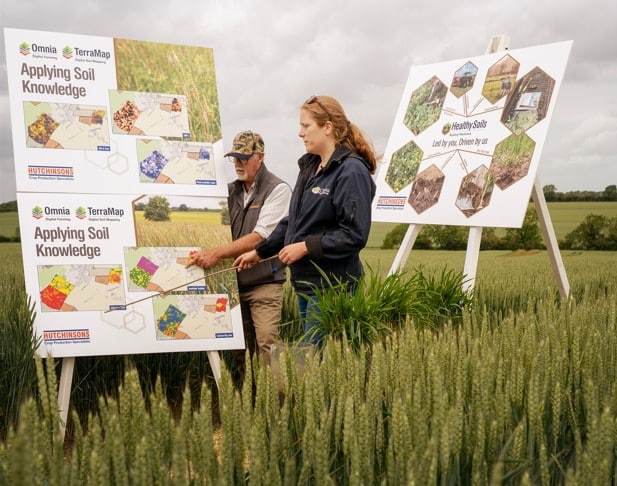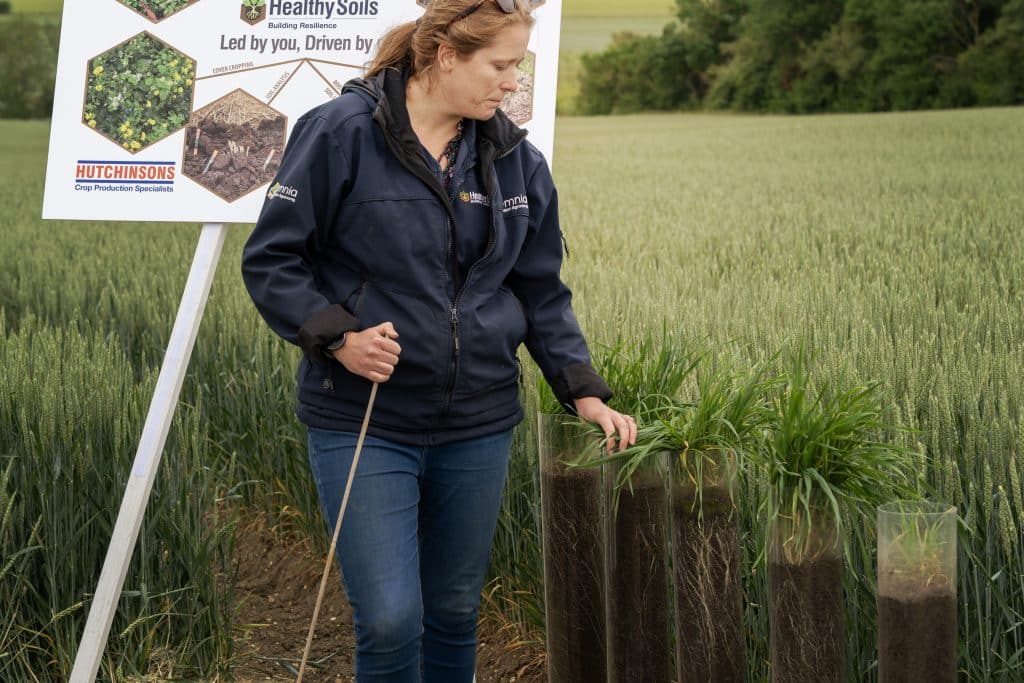Fresh approach to evolving black-grass situations – Farmers Guide
Black-grass control strategies need to change and adapt if growers are to keep on top of it. Paul Spackman visited the Hutchinsons Cambourne grassweed demonstration to learn more ...
Protracted black-grass germination, and populations dominated by fewer plants with aggressive tillering capacity. They are two important changes witnessed at South Sea Farm, home to the 40ha Hutchinsons black-grass demonstration site, kindly hosted by the Clear family.
Hutchinsons technical manager, Dick Neale, says these changes are representative of many other farms across the country, so growers need to understand what is happening (see panel) and refine grassweed management accordingly.
At South Sea Farm, a range of approaches is being taken, from meticulous soil management, to innovative cropping systems based around the “3C rotation” (catch, cover and companion crops), utilising the latest technology and knowledge.
“It’s about questioning and scrutinising everything that may, or may not, have an impact on black-grass in the field. In many cases, we’re simply optimising lots of simple things to do it better, from cultivations, cropping, variety choice, and seed rates, to drill type, sowing date, and placed nutrition to increase crop competition. There’s no single answer.”
Identifying problems
Mapping black-grass populations, and identifying potential causes, is key to targeting control strategies, and technology can help do this, Mr Neale continues.
At South Sea Farm, field populations have been mapped in Omnia using the Field Diary app and then overlaid against Terramap soil analysis. Properties such as the silt:clay ratio, plant available water, organic matter content, and the organic carbon:clay ratio are all useful indicators to highlight where the heaviest, wettest, soils are, and where black-grass is likely to thrive, says Hutchinsons soils specialist, Jade Prince.
Other factors, such as the calcium:magnesium ratio, also provide a good indicator of soil ‘tightness’ and workability, she notes. “These are high magnesium content soils, so we’ve used gypsum to address the issue – gypsum allows magnesium to be flushed lower into the soil, so the seedbed becomes more friable.”
Identifying nutrient levels across the field also helps to tailor fertiliser applications, which in turn, maximises crop establishment and competition against grassweeds, she adds.
Rooting competition
One way black-grass competes with crops is via its root mass, so Ms Prince says the team at Cambourne is examining whether a four-way wheat blend of Gleam, Champion, Dawsum and SY Insitor can increase rooting diversity, thereby maximising crop competition.
Growing individual wheat varieties in clear plastic tubes (rhizotrons) shows clear differences in rooting characteristics and intensity at different depths (see image), and she also points out that different roots release slightly different exudates, which helps support a wider range of soil biology.
Sequencing herbicides
The shift to more protracted germination has important consequences for herbicide programmes, with well-timed sequences offering far more effective control than large ‘stacks’ of residual chemistry soon after drilling.
This was evident in a herbicide trial at Cambourne, mirroring results from elsewhere, John Cussans of ADAS says.
“We’ve seen across a lot of different trials, that a herbicide sequence is more robust and gives the highest level of black-grass control compared with putting everything in the tank pre-em. Even with our best products, we still find they’re better used in a sequence, rather than as a single product at a single timing.
“But, we must maintain tight sequences, which for a September/ October drilled wheat, might start with a pre-em straight after drilling, followed by a second application 5-10 days later. As soon as that second application is delayed too long, control can really drop off, so you’ve got to be able to make it work.”
The Cambourne trials also highlighted the synergy that can occur when using pre-emergence tri-allate with other chemistry, compared with using the same actives on their own.
Fix drainage issues
Poor drainage has been the main cause of many black-grass issues at Cambourne, so there has been a concerted effort to repair existing drains and mole plough problem areas, Hutchinsons head of farm business consultancy, Will Foyle, says.
“Poor drainage not only increases waterlogging and creates conditions for black-grass to thrive, but it also reduces crop establishment and growth, thereby reducing crop competition and yield, and compromises the ability to travel on land at the optimum time, for cultivations, drilling, or herbicide applications.”
A cost benefit analysis of growing spring barley with and without good drainage, clearly shows the case for rectifying drainage problems (see table). The analysis is based on actual yields from a crop of Planet spring barley grown at South Sea Farm in 2024, where drainage problems were evident on parts of the field during the exceptionally wet spring.
“Such conditions won’t occur every year, but are definitely becoming more frequent,” notes Mr Foyle. “Yields were broadly representative of spring barley grown elsewhere on the farm that with poorer areas averaging year, just under 4t/ha, and better land just over 7t/ha.
“Drainage is something we really can’t neglect, offers one of the greatest returns on investment we can get. In this scenario, we were effectively £422/ha better off by investing in drainage, getting better crops, reducing black-grass and returning more money to the business.”
Drainage: cost:benefit analysis
*Note: Adjusted net margin assumes additional inversion cultivation cost of £60/ha to address extra seed return without drainage, and a herbicide saving of £40/ha where drainage has been improved and seed return is lower.
| Without drainage | With drainage | |
|---|---|---|
| Yield (t/ha) | 3.75 | 7.25 |
| Output (£/ha) | 769 | 1486 |
| Variable costs (£/ha) | 478 | 500 |
| Fixed costs (£/ha) | 475 | 475 |
| Net margin | -184 | 511 |
| Drainage costs (3/ha) - assumes an average cost of £3,000/ha, borrowed at 4.5% over 10 years | 0 | 373 |
| Black-grass seed return (%) | 150 | 35 |
| Adjusted net margin (£/ha)* | -244 | 178 |
Simple fixes first
When addressing field drainage issues, drainage contractor Rob Burtonshaw says to start by clearing ditches and any outflows to give water a route away from the field.
Growers should then identify any existing drains and check they are working. At Cambourne, original drainage maps were found and uploaded into Omnia to help pinpoint their exact locations in the field.
“Very few fields have never been drained, so there’s potentially thousands of pounds worth of asset in the ground that isn’t doing its job, but could, with a bit of attention,” says Mr Burtonshaw.
“If you can revitalise old drains, it can be a massive benefit, but in some situations, it may be necessary to install a new system. If that’s the case, make sure you accurately map the area that needs draining with GPS, and be sure to use good quality materials.”
Mole ploughing can make a huge difference to improving water infiltration, and has shown clearbenefits at South Sea Farm, but it must be done well to avoid making problems worse, he adds.
“Conditions are crucial, as it has to be dry enough on top to take the machines, but wet enough at depth to hold the mole shape. Also check how deep you need to go if planning to mole into the gravel backfill above field drains.”
In some situations, growers may need to adjust their rotation to create opportunities for mole ploughing problem areas, or be willing to sacrifice a bit of crop if opting to do it through the crop in the spring, he notes.
Changing emergence patterns
One trial at Cambourne neatly illustrates the protracted germination patterns now being seen. In the trial, plots were sprayed off with glyphosate every two weeks over the autumn and subsequent black-grass emergence recorded.
“After every glyphosate application, there was further black-grass germination, right through to end of November, notes Mr Neale. “They weren’t big numbers Like on many farms, stale seedbeds have been used very successfully for – 16 plants/m2 at the 26th Nov assessment – but it did keep coming!”
Like on many farms, stale seedbeds have been used very successfully for the last 8-10 years at South Sea Farm, and have largely exhausted the late-September/early Oct black-grass population, Mr Neale adds.
“We’re therefore not seeing the same performance from stale seedbeds anymore. Black-grass numbers are down by a factor of 10 compared with what, we used to see at our old Brampton site. Instead of 400-600 plants/m2, we’re now dealing with 40-60/m2. But their ability to tiller is pretty strong, with some producing more than 40 tillers per plant.
“Because we are dealing with lower numbers of black-grass, there is a strong argument for drilling slightly earlier (e.g. early October) to help create a more competitive crop against that lower black-grass population. It’s something we are looking at in the trials, as well as other ways to maximise crop competition.”

